人教版(2019)选择性必修第三册 Unit 5 Poems Writing教学课件(共23张PPT)
文档属性
| 名称 | 人教版(2019)选择性必修第三册 Unit 5 Poems Writing教学课件(共23张PPT) | 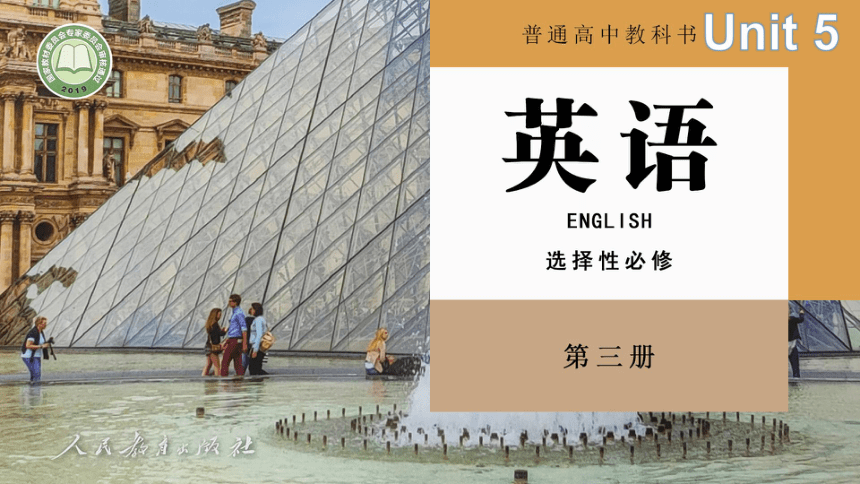 | |
| 格式 | pptx | ||
| 文件大小 | 5.5MB | ||
| 资源类型 | 教案 | ||
| 版本资源 | 人教版(2019) | ||
| 科目 | 英语 | ||
| 更新时间 | 2023-03-31 15:12:48 | ||
图片预览


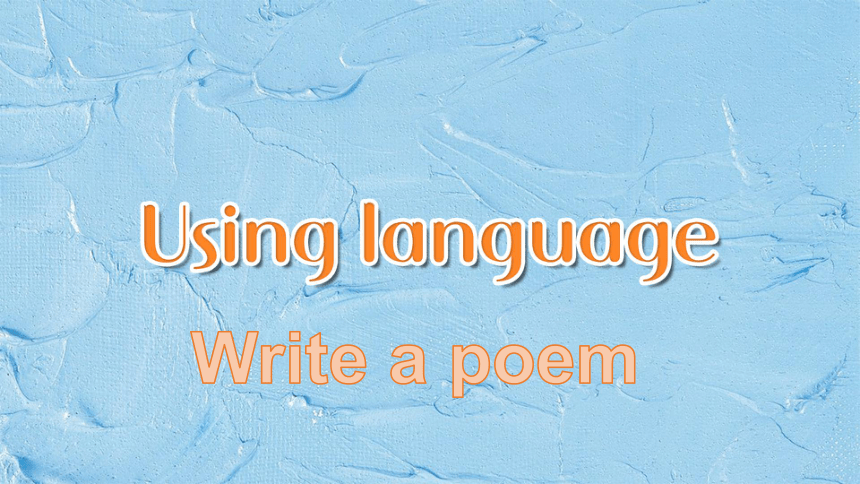
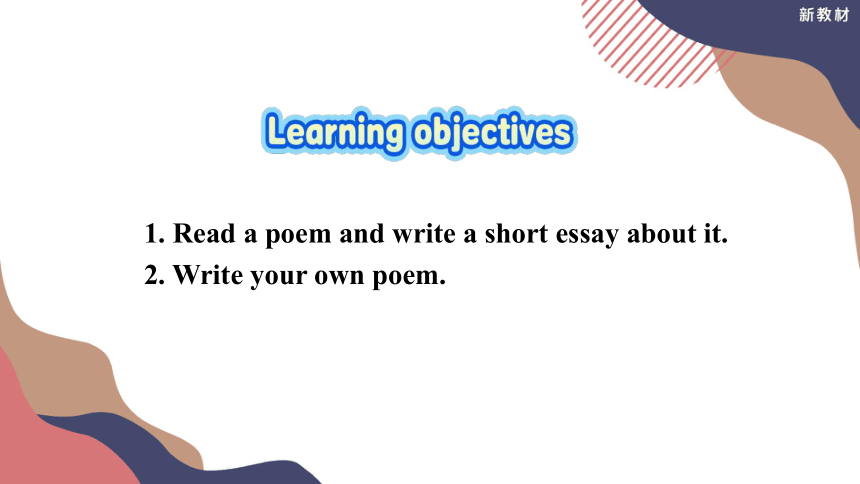
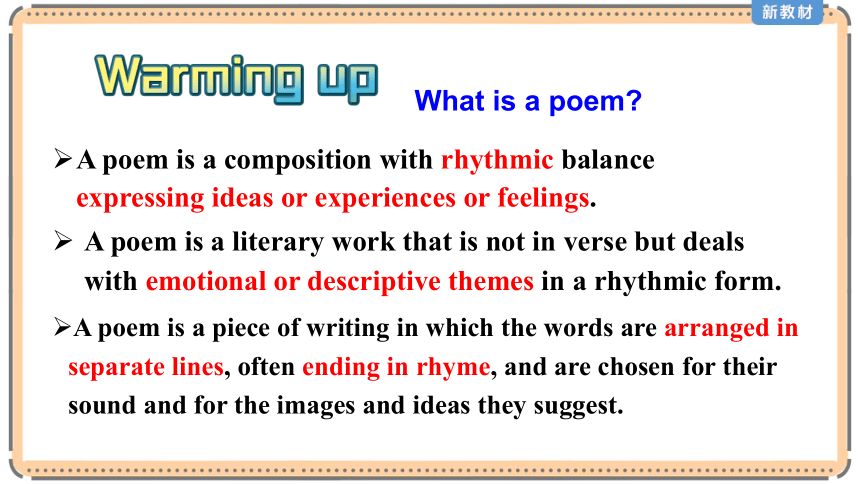
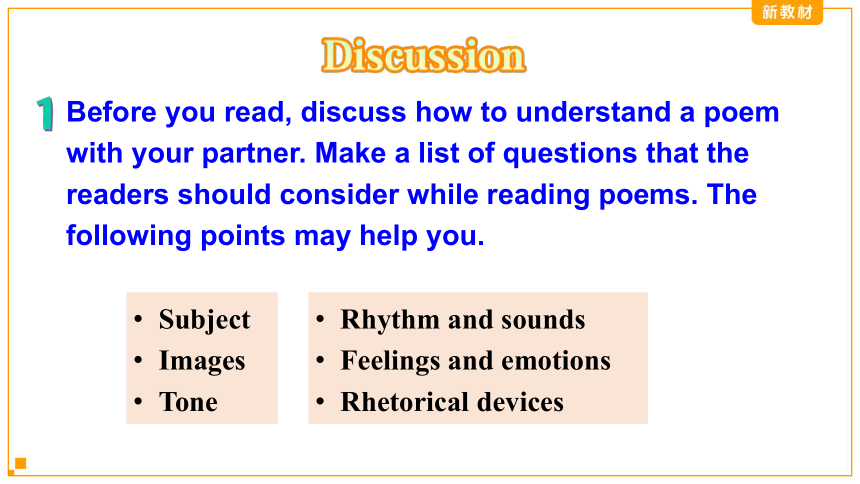
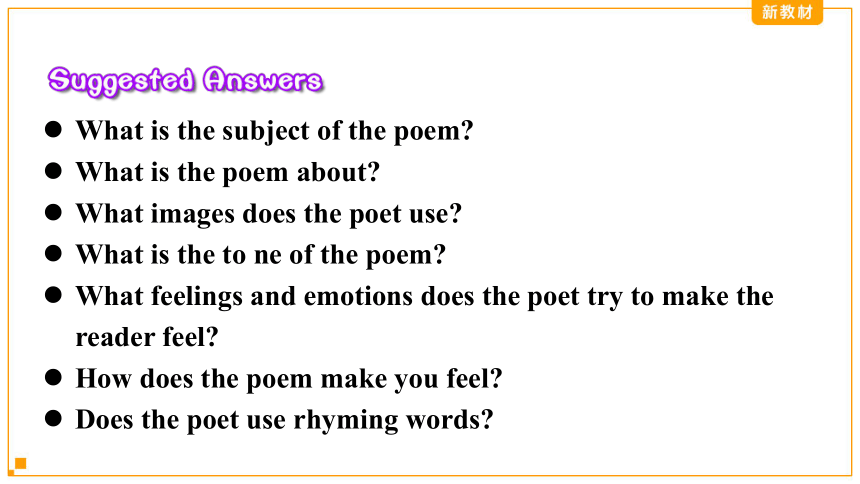
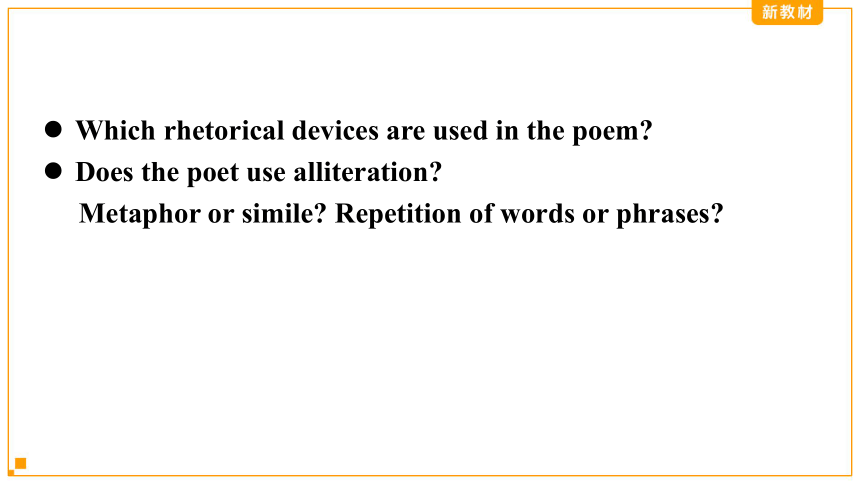
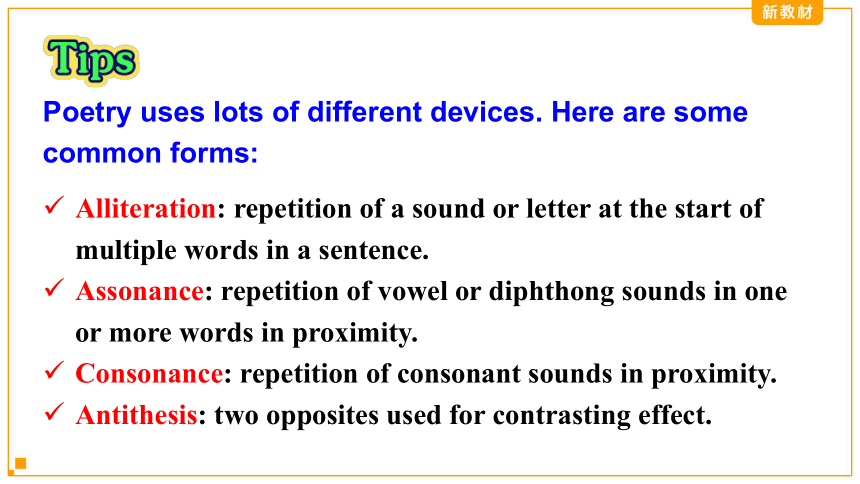
文档简介
(共23张PPT)
Unit 5
UNIT 5 POEMS
Write a poem
1. Read a poem and write a short essay about it.
2. Write your own poem.
What is a poem
A poem is a composition with rhythmic balance expressing ideas or experiences or feelings.
A poem is a literary work that is not in verse but deals with emotional or descriptive themes in a rhythmic form.
A poem is a piece of writing in which the words are arranged in separate lines, often ending in rhyme, and are chosen for their sound and for the images and ideas they suggest.
Before you read, discuss how to understand a poem with your partner. Make a list of questions that the readers should consider while reading poems. The following points may help you.
Subject
Images
Tone
Rhythm and sounds
Feelings and emotions
Rhetorical devices
What is the subject of the poem
What is the poem about
What images does the poet use
What is the to ne of the poem
What feelings and emotions does the poet try to make the reader feel
How does the poem make you feel
Does the poet use rhyming words
Which rhetorical devices are used in the poem
Does the poet use alliteration
Metaphor or simile Repetition of words or phrases
Alliteration: repetition of a sound or letter at the start of multiple words in a sentence.
Assonance: repetition of vowel or diphthong sounds in one or more words in proximity.
Consonance: repetition of consonant sounds in proximity.
Antithesis: two opposites used for contrasting effect.
Poetry uses lots of different devices. Here are some common forms:
Rhetoric/ Rhetorical question: asked to make a point rather than to expect an answer.
Metaphor: comparing one thing to another
Simile: comparing one thing to another, using “like”
Refrain: repeating a line or verse at the end of a atanza or at regular intervals.
Phonetic symbolism: words with the same sound and associated meaning.
Anaphora: repetition of the first part of the sentence.
Read the poems and answer the questions.
What kind of poem is it
What’s the topic
How do some sentences rhyme
How is the language organised
What picture comes to your mind after you read the poem
What inspiration have you got from the poem
Wind on the Hill Dream A Match
Subject
Images
Rhyming words
Rhetorical devices
wind
kite, person
dream
broken-winged bird, barren field frozen with snow
love
rose, leaf, fields
Complete the table.
knows/goes
can/ran kite/ night blew/too goes/ knows
die / fly
go / snow
together/weather
closes/is
grief/leaf
repetition
alliteration
repetition
metaphor
repetition
metaphor, simile
Choose one of the poems and write a short essay about it.
How to write a short essay about a poem
如何写诗歌赏析类文章
写法一: 通过对全诗的整体分析,表达自己的观点 写法二:
就诗歌最突出的方面进行分析,表达自己的见解。
写法一
一篇较完整的诗歌赏析类文章包含如下内容:
4.
作品的艺术手法分析
(通常结合在作品意向分析之中)
5.
作品艺术特点的综合评价
(常带有总结的意味)
写法二
采用这种写法时,作者只需要抓住其中一个方面,如意境、语言表达、某一手法等。对于其他方面则可不提及,因而采用这种写法的文章篇幅一般较短小。
4.
作品的艺术手法分析
(通常结合在作品意向分析之中)
5.
作品艺术特点的综合评价
(常带有总结的意味)
Here is a poem titled ... by...
It is popular with Chinese readers.
This poem is about nature and life.
It is written with special writing skills.
It rhymes at the end of each line.
The language of the poem is descriptive and vivid.
4.
作品的艺术手法分析
(通常结合在作品意向分析之中)
Whenever we read this poem, some characters appear clearly.
Only by reading it repeatedly can we grasp the spirit of this poem.
Considered as one of the greatest poets of the Tang Dynasty,… will undoubtedly live in people’s heart forever.
In my opinion, the young generation today should understand and learnt form the poem.
Write your own poem by following these steps.
Start with the theme first. Ask yourself, “What message do I want to give to the reader What is important to me ”
Next, think about the words and phrases you would like to use. Make a list of words related to your theme.
Then check how well your details paint a picture in your need. Now write the poem. Read it aloud and listen to how it sounds.
Finally, give it a title. Now your poem is ready!
Now write your poem.
Work in groups. Take turns to read aloud your poems and then have a discussion on what you think they mean. Give your personal opinion or advice based on what you have learnt from this unit.
Read aloud your poem to the class or put it up in the classroom.
Revise your poem with the help of your group members or what you have learnt from this unit.
Share your poem with the class and put it up in the classroom.
Unit 5
UNIT 5 POEMS
Write a poem
1. Read a poem and write a short essay about it.
2. Write your own poem.
What is a poem
A poem is a composition with rhythmic balance expressing ideas or experiences or feelings.
A poem is a literary work that is not in verse but deals with emotional or descriptive themes in a rhythmic form.
A poem is a piece of writing in which the words are arranged in separate lines, often ending in rhyme, and are chosen for their sound and for the images and ideas they suggest.
Before you read, discuss how to understand a poem with your partner. Make a list of questions that the readers should consider while reading poems. The following points may help you.
Subject
Images
Tone
Rhythm and sounds
Feelings and emotions
Rhetorical devices
What is the subject of the poem
What is the poem about
What images does the poet use
What is the to ne of the poem
What feelings and emotions does the poet try to make the reader feel
How does the poem make you feel
Does the poet use rhyming words
Which rhetorical devices are used in the poem
Does the poet use alliteration
Metaphor or simile Repetition of words or phrases
Alliteration: repetition of a sound or letter at the start of multiple words in a sentence.
Assonance: repetition of vowel or diphthong sounds in one or more words in proximity.
Consonance: repetition of consonant sounds in proximity.
Antithesis: two opposites used for contrasting effect.
Poetry uses lots of different devices. Here are some common forms:
Rhetoric/ Rhetorical question: asked to make a point rather than to expect an answer.
Metaphor: comparing one thing to another
Simile: comparing one thing to another, using “like”
Refrain: repeating a line or verse at the end of a atanza or at regular intervals.
Phonetic symbolism: words with the same sound and associated meaning.
Anaphora: repetition of the first part of the sentence.
Read the poems and answer the questions.
What kind of poem is it
What’s the topic
How do some sentences rhyme
How is the language organised
What picture comes to your mind after you read the poem
What inspiration have you got from the poem
Wind on the Hill Dream A Match
Subject
Images
Rhyming words
Rhetorical devices
wind
kite, person
dream
broken-winged bird, barren field frozen with snow
love
rose, leaf, fields
Complete the table.
knows/goes
can/ran kite/ night blew/too goes/ knows
die / fly
go / snow
together/weather
closes/is
grief/leaf
repetition
alliteration
repetition
metaphor
repetition
metaphor, simile
Choose one of the poems and write a short essay about it.
How to write a short essay about a poem
如何写诗歌赏析类文章
写法一: 通过对全诗的整体分析,表达自己的观点 写法二:
就诗歌最突出的方面进行分析,表达自己的见解。
写法一
一篇较完整的诗歌赏析类文章包含如下内容:
4.
作品的艺术手法分析
(通常结合在作品意向分析之中)
5.
作品艺术特点的综合评价
(常带有总结的意味)
写法二
采用这种写法时,作者只需要抓住其中一个方面,如意境、语言表达、某一手法等。对于其他方面则可不提及,因而采用这种写法的文章篇幅一般较短小。
4.
作品的艺术手法分析
(通常结合在作品意向分析之中)
5.
作品艺术特点的综合评价
(常带有总结的意味)
Here is a poem titled ... by...
It is popular with Chinese readers.
This poem is about nature and life.
It is written with special writing skills.
It rhymes at the end of each line.
The language of the poem is descriptive and vivid.
4.
作品的艺术手法分析
(通常结合在作品意向分析之中)
Whenever we read this poem, some characters appear clearly.
Only by reading it repeatedly can we grasp the spirit of this poem.
Considered as one of the greatest poets of the Tang Dynasty,… will undoubtedly live in people’s heart forever.
In my opinion, the young generation today should understand and learnt form the poem.
Write your own poem by following these steps.
Start with the theme first. Ask yourself, “What message do I want to give to the reader What is important to me ”
Next, think about the words and phrases you would like to use. Make a list of words related to your theme.
Then check how well your details paint a picture in your need. Now write the poem. Read it aloud and listen to how it sounds.
Finally, give it a title. Now your poem is ready!
Now write your poem.
Work in groups. Take turns to read aloud your poems and then have a discussion on what you think they mean. Give your personal opinion or advice based on what you have learnt from this unit.
Read aloud your poem to the class or put it up in the classroom.
Revise your poem with the help of your group members or what you have learnt from this unit.
Share your poem with the class and put it up in the classroom.
